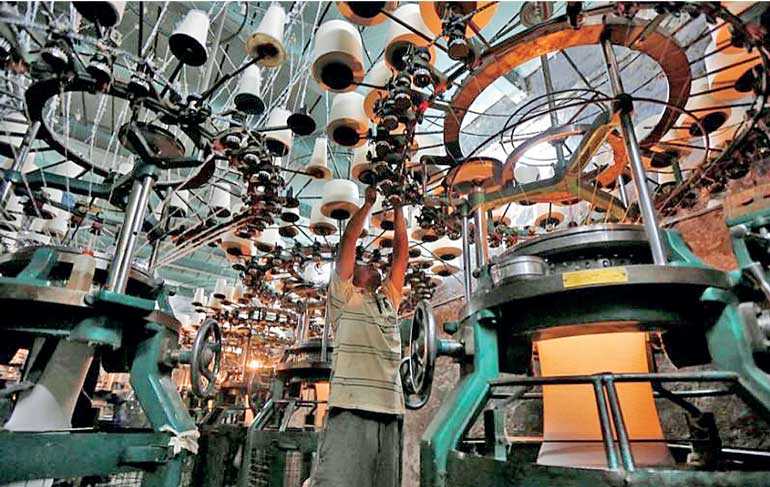Thursday Mar 06, 2025
Thursday Mar 06, 2025
Monday, 4 June 2018 00:00 - - {{hitsCtrl.values.hits}}

File Photo - An employee works inside an undergarment factory in Kolkata, India, REUTERS/Rupak De Chowdhuri
NEW DELHI (Reuters): The Indian economy grew 7.7% year-on-year in January-March, its quickest pace in nearly two years driven by higher growth in manufacturing, the farm sector and construction.
The figure surpassed China’s growth rate of 6.8% in the January-March quarter, confirming India as the fastest growing major economy.
For the fiscal year that ended March 31, the Ministry of Statistics reported growth of 6.7%, down from 7.1% for a year earlier. However, economists expect growth to be robust in the current financial year.
“Investment activity has picked up,” Economic Affairs Secretary Subhash Chandra Garg told reporters, adding that the government expected a further acceleration in the coming year. India also reported 4.7% growth in annual infrastructure output in April, signalling a recovery after it slipped to a three-year low of 4.2% in 2017/18. Construction activity jumped to 11.5% during January-March, after a 3.9% drop in the year-ago period. Analysts said this reflected the fading impact of the Government’s move to scrap high-value bank notes that disrupted supply chains and caused job losses.
The data may offer a boost to Prime Minister Narendra Modi, who is set to seek a second term next year. His Government launched a nationwide Goods and Services Tax (GST) but its introduction was botched, nearly scuttling India’s growth prospects in the near term.
“(It) seems like we have moved beyond the teething troubles related to GST implementation,” said Tushar Arora, a senior economist at HDFC Bank. “The pick-up in investment activity is also a good sign.”
The faster pace of growth in the latest quarter might also strengthen expectations of an interest rate increase by the Indian central bank when it reviews monetary policy next week.
About 40% of economists polled by Reuters expected a rate rise next week, driven by higher inflation at 4.58% in April, above the Reserve Bank of India’s target of 4% for the sixth month in a row.
Growth in Asia’s third-largest economy, reported by the ministry, trumped forecasts in a Reuters poll of annual growth at 7.3%.
The ministry revised the October-December annual growth down to 7.0% from the provisional 7.2% it reported earlier.
India’s recovery could be threatened by higher global crude oil prices, which this month hit $80 a barrel, their highest since 2014.
India meets 80% of its oil needs from imports.
Higher oil prices have already pressured the rupee, near a record low last week and Asia’s worst performer.
Alongside, rising global trade tensions due to the imposition of import tariffs by the United States could moderate global trade growth, tempering Indian exports, analysts said.
“We have cut our FY19 GDP forecast by 20 basis points taking into account rising oil prices and potential global trade wars,” said Teresa John, economist, Nirmal Bang Institutional Equities in Mumbai.
However, growth is likely to get a boost from monsoon rains, which hit the southern state of Kerala a few days earlier than normal, potentially brightening the outlook for agricultural output. Monsoons deliver about 70% of India’s annual rainfall and are the lifeblood of its $2.5 trillion economy, spurring farm output and boosting rural spending. The International Monetary Fund expects economic growth could reach 7.4% in 2018/19.
Discover Kapruka, the leading online shopping platform in Sri Lanka, where you can conveniently send Gifts and Flowers to your loved ones for any event including Valentine ’s Day. Explore a wide range of popular Shopping Categories on Kapruka, including Toys, Groceries, Electronics, Birthday Cakes, Fruits, Chocolates, Flower Bouquets, Clothing, Watches, Lingerie, Gift Sets and Jewellery. Also if you’re interested in selling with Kapruka, Partner Central by Kapruka is the best solution to start with. Moreover, through Kapruka Global Shop, you can also enjoy the convenience of purchasing products from renowned platforms like Amazon and eBay and have them delivered to Sri Lanka.
Discover Kapruka, the leading online shopping platform in Sri Lanka, where you can conveniently send Gifts and Flowers to your loved ones for any event including Valentine ’s Day. Explore a wide range of popular Shopping Categories on Kapruka, including Toys, Groceries, Electronics, Birthday Cakes, Fruits, Chocolates, Flower Bouquets, Clothing, Watches, Lingerie, Gift Sets and Jewellery. Also if you’re interested in selling with Kapruka, Partner Central by Kapruka is the best solution to start with. Moreover, through Kapruka Global Shop, you can also enjoy the convenience of purchasing products from renowned platforms like Amazon and eBay and have them delivered to Sri Lanka.